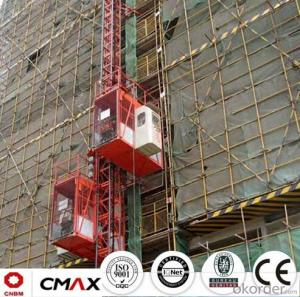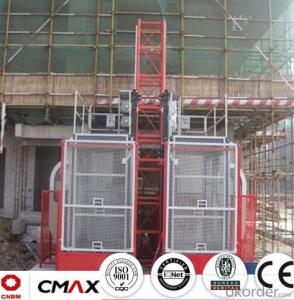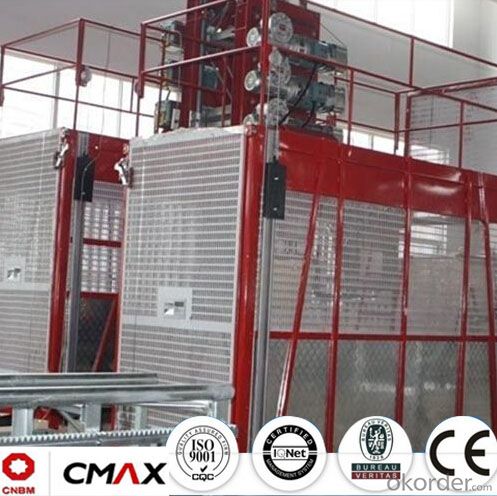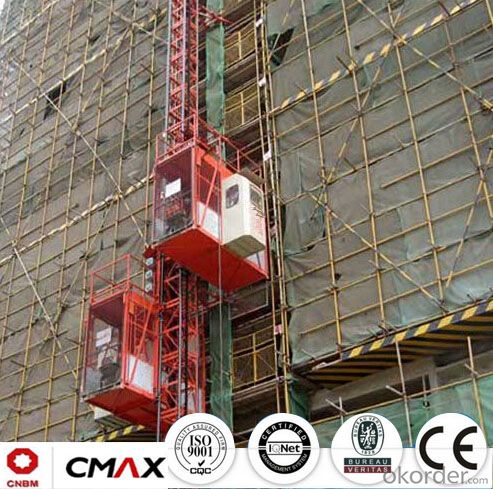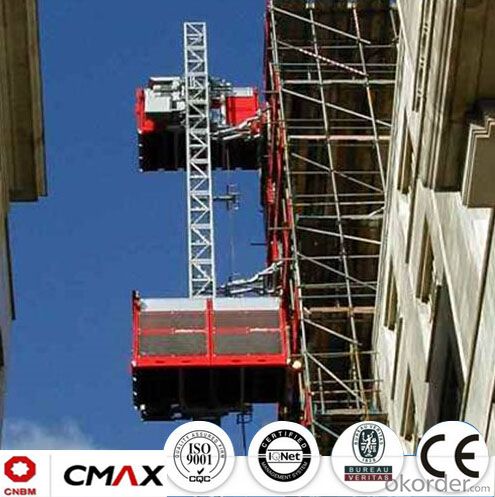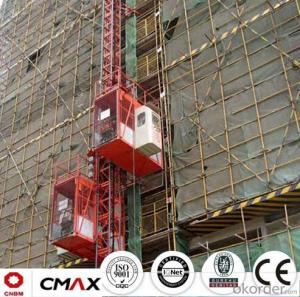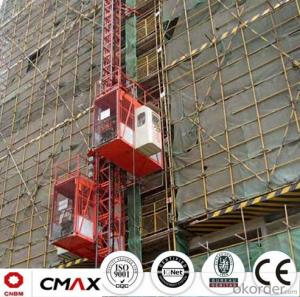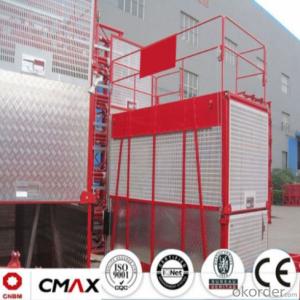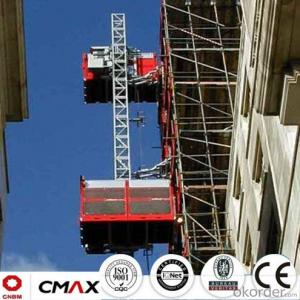Building Hoist European Standard Electric Parts with 5.4ton Capacity
- Loading Port:
- China main port
- Payment Terms:
- TT OR LC
- Min Order Qty:
- 1 unit
- Supply Capability:
- 10 unit/month
OKorder Service Pledge
OKorder Financial Service
You Might Also Like
Structure of Building Hoist Description
1.The gearing adopts imported bearing,enameled cable and oil seal.
2.The electric parts adopt products from world renowned manufacturers such as Schneider,Siemens and LG.
3.The racks and pinion adopts special material and heat-treatment technique,which prolong the life of these parts.
4.The steel structure uses quality steel from famous domestic manufacturers.
5.The surface of the structure can apply paint-spray,parkerizing baking finish or hot galvanizing processing according to users requirement.
6.The cage can be produced and decorated by aluminum molded board,punched-plate or figured aluminum board.
Packaging & Delivery of Building Hoist
Packaging: nude and wooded box Delivery: 25-30days
Mains Parts of Building Hoist
1.Metal structure including the mast, tie in and cabin ,could be spay-painted and hot galvanized. Mast section is produced with high quality Q345B seamless steel pipe.
2.Electric parts are all equipped with Schneider , Siemens and other top brands.
3.The electrical system can be adopted with the normal control method and VVVF+PLC control method. Inverter we adopted is from Schneider. Yaskawa and other world famous brand.
4.Cabin exit door adopts ramping type. The ramping door likes a bridge between the building hoist and construction building.
5.The cabin floor is produced from 3MM thickness steel riffled board(Hot dip galvanized), and 15MM thickness wooden board which can reduce the vibration and deformation a lot.
6.Driving unit is adopted the products from ZHANGJIANG and other reputed maker, or from SEW, NORD.
7.Safety system is mainly composed of electrical motor braking, anti-drop safety device, top & bottom limit switches, top & bottom 3-phase switches, door limit switches, buffer device and over-load protection. The system aims to ensure the hoist are running safely.
8.Qualification: CE, ISO9001:2008 and etc.
9.The long-term operation of CMAX building hoists testifies CMAX hoist is working performance is stable.
Building Hoist Images



Building Hoist Specification

FAQ of Building Hosit
Q: What is the building hoist main purpose?
A: Building hoist equipped with double or single cabin to transport the materials and labors up and down. It's the ideal construction equipment for vertical transportation in the field of construction.
Q: What is the main structure of building hoist?
A: The P/M construction hoist mainly contains metal structure, driving system, electrical control system, cable guide & protection system, electrical top crane and safety device.
Q: What is the meaning of the building hoist’s code?
A: Take SC200/200 for example: “SC” stands for rack and pinion hoist, “200/200” stands for double cage and capacity is 2 tons per cage. “SC200” stands for single cage and capacity is 2 tons.
Q: What is the dimension of the cage?
A: Normally the cage dimension is 3X1.5X2.5M (L/W/H) for 2t type hoist. Details should be checked according to our
quotation sheet. Also, the size can be customized according to the factual site condition. There are two doors (entrance& exit doors) for each cage, It can be produced as up & down sliding or ramping model for safety and convenience.
- Q: This question asks for a guide on how to change the tightness of the ropes on a construction hoist.
- <p>Adjusting the tension on a building hoist involves several steps. First, ensure the hoist is powered off and secured to prevent any movement. Locate the rope tensioning mechanism, often found at the base or top of the hoist. This could be a ratchet system, a spring-loaded mechanism, or a manual adjustment bolt. For ratchet systems, adjust the tension by turning the ratchet handle to tighten or loosen the rope. For spring-loaded mechanisms, adjust the spring tension by turning the adjustment bolt. Ensure the rope is properly seated in the pulley system and not frayed or damaged. After adjusting, test the hoist with a small load to ensure the tension is appropriate and the hoist operates smoothly. Always refer to the manufacturer's manual for specific instructions and safety precautions.</p>
- Q: This question asks for a comparison between electric and pneumatic building hoists, highlighting their distinct features and operational differences.
- <p>Electric building hoists are powered by electricity and are known for their high lifting capacity, speed, and efficiency. They are suitable for heavy-duty applications and can be automated for continuous operation. Pneumatic hoists, on the other hand, use compressed air to generate lifting force. They are quieter, require less maintenance, and are safer in environments where electrical sparks could be hazardous. However, they have lower lifting capacities and are generally slower compared to electric hoists. Pneumatic hoists are also more suitable for applications requiring precise control over the load.</p>
- Q: How do construction suspension scaffolding be handled in the people's elevator?
- You need to transfer at the scaffold poling build-up on the cantilever beams, and one cargo lift scaffolding and scaffolding disconnect processing, so that not only is the stress problem, and is an outer layer removed, people transfer the general is still there, easy to keep people transfer at the shelf.
- Q: Excuse me: what is the meaning of heavy weight in the construction elevator?
- That's what it means to be heavyReally, I hope to have more good posts
- Q: What steps are necessary to guarantee the safety and reliability of a building hoist?
- <p>To ensure a building hoist is safe and reliable for use, follow these steps: Conduct regular inspections and maintenance by qualified personnel. Check all mechanical and electrical components for wear and tear. Ensure all safety features, such as emergency stop buttons and limit switches, are functioning correctly. Verify that the hoist is properly secured to the building and that all load-bearing elements are capable of handling the weight. Adhere to the manufacturer's guidelines and specifications for operation. Train operators on the proper use of the hoist and emergency procedures. Regularly test the hoist's load capacity and stability. Keep records of all inspections, maintenance, and any incidents for future reference.</p>
- Q: What are the primary materials and components typically utilized in the construction of building hoists?
- <p>Building hoists, also known as construction hoists, are typically made from a combination of steel, aluminum, and sometimes plastic. The frame and main structure are usually constructed from steel for strength and durability. Aluminum is often used for components like the platform and railing due to its lightweight properties, which can reduce the overall weight of the hoist. Plastic components may be used for certain parts to enhance resistance to weather and corrosion. Additionally, hoists may incorporate electrical and mechanical systems, which include cables, gears, and motors, to facilitate the hoisting and lowering of materials and personnel.</p>
- Q: Explain the key differences between electric and hydraulic lifting equipment, including their power sources, efficiency, and applications.
- <p>Electric lifting equipment is powered by electric motors and typically operates through cables or batteries, making them quieter and more environmentally friendly. They are often used in indoor settings where noise and emissions are a concern. Hydraulic lifting equipment, on the other hand, uses hydraulic fluid and pistons to generate force, providing high power and torque. They are commonly used in heavy-duty applications and outdoors. Electric systems are generally more energy-efficient and have lower maintenance costs, while hydraulic systems offer greater power density and can handle heavier loads.</p>
- Q: Is it possible to utilize a building hoist to lift objects with varying dimensions and weights?
- <p>Yes, building hoists are designed to lift a variety of objects with different sizes and weights. However, each hoist has specific weight and size limitations that must be adhered to for safety and operational reasons. It's crucial to ensure that the objects being lifted are within the hoist's capacity to prevent accidents and damage. Always consult the manufacturer's specifications and safety guidelines before using a hoist for lifting operations.</p>
- Q: What is the highest weight a building hoist can safely lift?
- <p>The maximum load capacity of a building hoist can vary significantly depending on the specific model and design. Generally, capacities range from 500 kg to 3,000 kg or more. It's crucial to refer to the manufacturer's specifications for the exact load capacity of any given hoist. Overloading a hoist can lead to accidents and damage, so it's essential to operate within the specified limits.</p>
- Q: This question asks for a comparison of the pros and cons associated with the use of building hoists in construction projects.
- <p>Building hoists offer several advantages, including increased efficiency in material transportation, reduced labor costs, and improved safety by minimizing the need for manual handling at height. They can also be used for personnel transport, enhancing site accessibility. However, there are disadvantages such as high initial costs, the need for regular maintenance and inspection, and potential downtime due to mechanical issues. Additionally, they require space for installation and can obstruct views or access during operation. Safety concerns also arise if not properly managed, as accidents can occur due to operator error or mechanical failure.</p>
Send your message to us
Building Hoist European Standard Electric Parts with 5.4ton Capacity
- Loading Port:
- China main port
- Payment Terms:
- TT OR LC
- Min Order Qty:
- 1 unit
- Supply Capability:
- 10 unit/month
OKorder Service Pledge
OKorder Financial Service
Similar products
Hot products
Hot Searches
Related keywords

